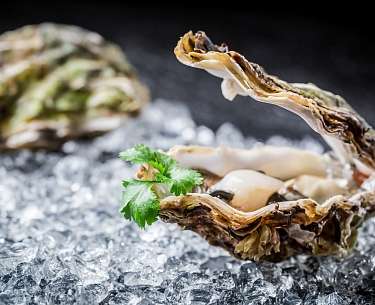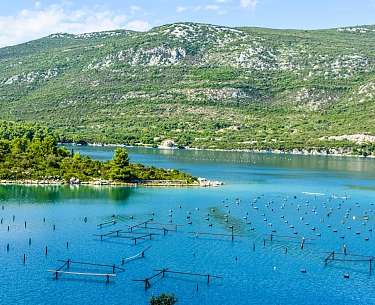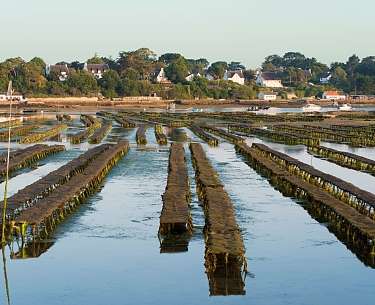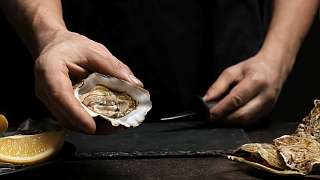Romantik Blog

Luxury that tastes good
They appear rugged and forbidding on the outside. But once they are cracked, they reward with their unique taste. Aromatic, finely salted, with a bite and the scent of the sea, of sea spray and the coast.
The most elegant of all mussel varieties was already popular with the ancient Romans. As the fruit of Venus, the goddess of love, it was considered an aphrodisiac and still stands for luxury and pleasure today. Yet it could easily be called a superfood because it contains numerous vitamins and minerals, but hardly any fat or carbohydrates. Oyster expert and star chef Wilco Berends from Romantik Hotel De Nederlanden (Vreeland, Netherlands): "To enjoy the full taste of an oyster, you shouldn't just slurp and swallow it. The longer you chew, the more intensively the characteristic flavours unfold."
Oysters prefer to grow on the rocks of shallow tidal waters, thriving best in clean salt water or areas where salt and fresh water meet. After breeding, the oysters are detached from the reef with rakes or ropes and then collected by hand or machine. They are then cleaned in clarification tanks before being sold on the market.

Citrus mixture for oysters
Ingredients:
- 50 gr. grapefruit, 10 gr. juice
40 gr. orange juice
10 gr. lemon, 5 gr. juice
15 gr. soy sauce
Preparation:
Fillet the citrus fruits and cut them into small pieces. Mix the juices with 15 gr. soy sauce, pour over the oyster and garnish with fruit fillets.
Open correctly
When opening the oyster, use a kitchen towel or a special oyster glove to avoid injury. Hold the oyster with the belly side down, the pointed part facing your own body. Place the oyster knife on this tip, the hinge, and insert it with light pressure. Now, using twisting movements of the knife, spread the shell open, cut the sphincter inside and remove the upper shell. Remove the oyster meat from the shell with the knife - done.
When are oysters in season?
The classic rule says that months with "r" are ideal. The reason for the rule was that oysters reproduce in the summer months and the resulting milky flesh consistency and lack of quality. To escape this time restriction, so-called triploid oysters are now mainly bred. These hermaphrodites do not have to reproduce and are therefore edible all year round. Since they also grow one and a half times faster, they are also very popular with oyster farmers due to higher yields. There are over 50 different species in the world. They are mainly divided into the shallow, round European oyster and the rather deep and elongated Pacific rock oyster. The varieties are usually named after their origin.
Quite versatile
The most important thing when buying an oyster is that it is fresh. The oyster should therefore still be alive and sealed. Classically, oysters are served raw in their shells, on ice and with lemon slices. However, the noble seafood can also be cooked or baked. Star chef Wilco Berends loves to serve oysters in different variations. His creations such as baked oysters with duck liver and chicken, with gin and tonic or with vodka and caviar often convince even oyster sceptics: "Many guests get a taste for oysters this way, even if they didn't want to try them before.

The most popular oysters
Limfjord
Grown on the northernmost oyster banks in the world, this Danish variety is considered one of the best. Hardly salty due to the fjord water, rather mild in taste.
Marennes
Native to the French Atlantic, this popular variety tastes intensely of the sea. Recognisable by its green flesh.
Gillardeau
Named after its producer Gérard Gillardeau, this variety is extremely popular with gourmets. Slightly nutty and delicately spicy aroma.

Belon
Supposedly the best type of oyster, named after the river in Brittany, grows not on rocks but in the silt. Slightly nutty taste.
Sylter Royal
The only German oyster variety, grown in the Lister Wadden Sea. High meat content and nutty, minimally salty taste.
TsarSkaya
One of the most exclusive varieties, matured in the bay of Mont-Saint-Michel. Creamy and meaty texture with a marine and slightly sweet taste.
Post your comment
Comments
No one has commented on this page yet.
RSS feed for comments on this page RSS feed for all comments



